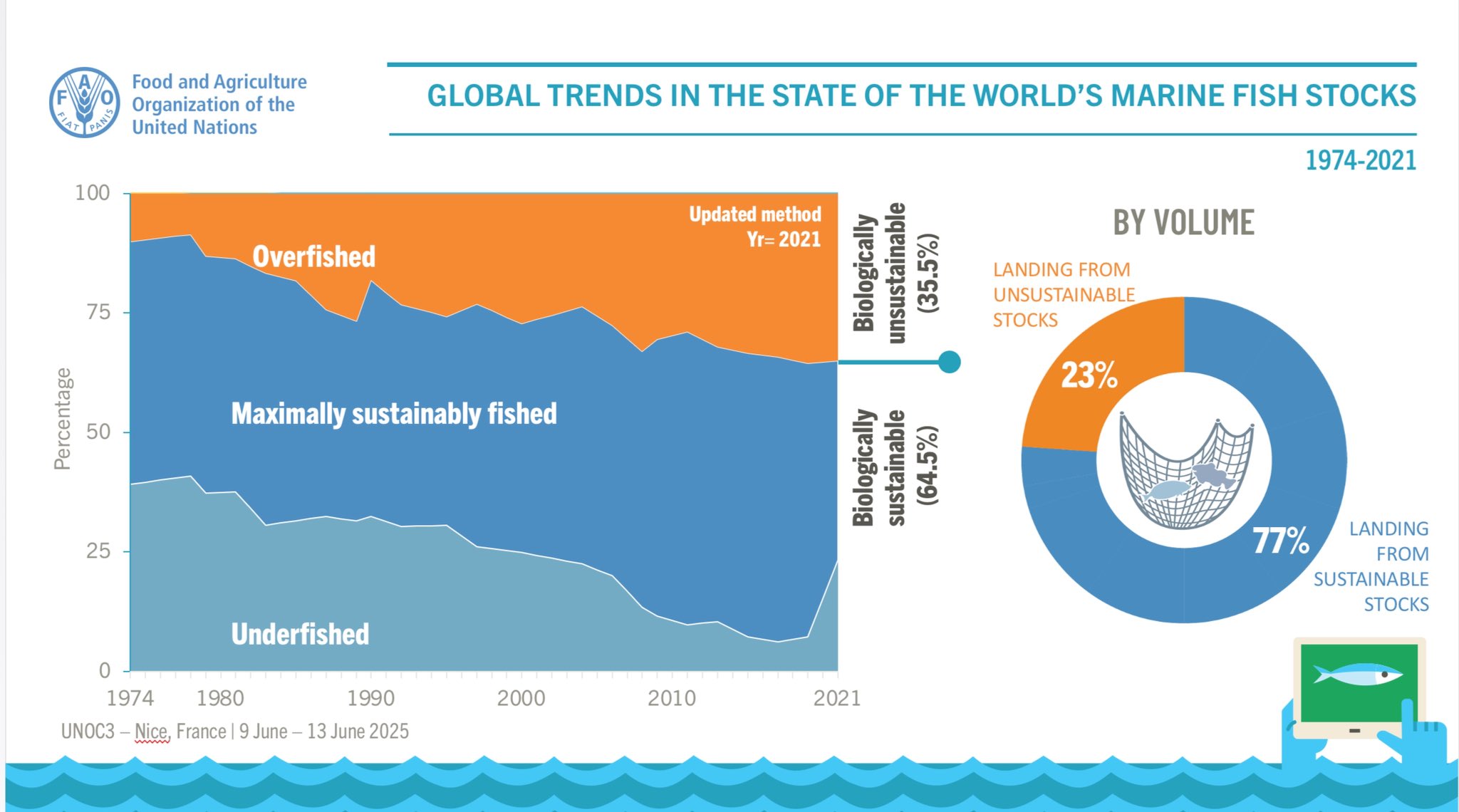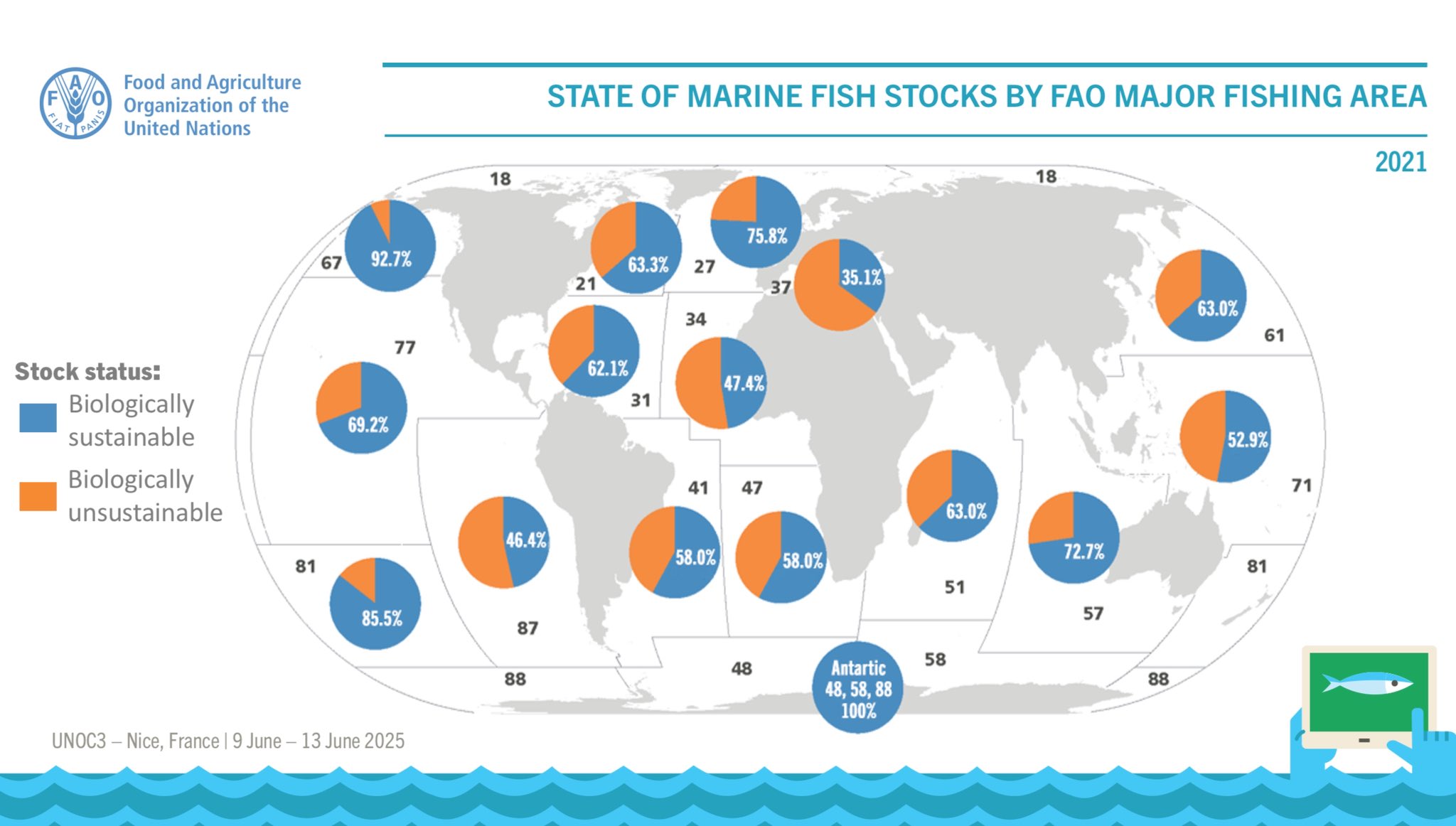Context:
The Food and Agriculture Organization (FAO) has released its 2025 edition of the Review of the State of World Marine Fishery Resources at the United Nations Ocean Conference 3 (UNOC3) in Nice, France.
· This biennial report presents a comprehensive global analysis of the health and sustainability of marine fish stocks, drawing on contributions from over 600 experts, 200 institutions, and 90 countries.
Key Findings:
Global Fish Stock Status
- 64.5% of global fishery stocks are within biologically sustainable levels.
- 35.5% are overfished, meaning fish are being harvested at rates that risk depleting populations.
- FAO defines a stock as overfished if its biomass is below 80% of the level that supports maximum sustainable yield (MSY) — the highest catch that can be maintained over time without reducing the stock.
Deep-Sea Species:
- Only 29% of deep-sea fish stocks are sustainably fished.
- These species face unique biological challenges:
- Late maturation
- Slow growth
- Long life expectancy
- Low natural mortality
- Infrequent spawning
- These characteristics make deep-sea species highly vulnerable to overexploitation and slow to recover.
Shark Fisheries at Risk
- Over half of highly migratory shark stocks are unsustainably fished.
- Of 23 assessed shark stocks across seven species:
- 43.5% are overfished.
- Sharks are frequently caught as bycatch in tuna fisheries.
- The highest annual shark catches are found in:
- Western Central Pacific
- Eastern Indian Ocean
- Western Indian Ocean
- Sharks and rays are particularly prone to overexploitation due to biological sensitivity and limited resilience.
Regional Trends in Sustainability
- Northeast and Southwest Pacific: High sustainability due to effective fishery management systems.
- Mediterranean and Black Seas: Only 35.1% of stocks are sustainably fished.
- Southeastern Pacific: Sustainability stands at 46.4%.
- Eastern Indian Ocean: An estimated 72.7% of stocks are sustainable, but the data is limited and may exclude vulnerable species.
Role of Management Systems:
- Regions with strong management frameworks show better stock sustainability.
- Tuna stocks in the high seas perform well, with 87% of assessed stocks considered sustainable.
- Success attributed to Regional Fisheries Management Organizations (RFMOs) that ensure:
- Robust data collection
- Onboard monitoring systems
- Accurate landing records
- Enforced compliance mechanisms
High Seas and Areas Beyond National Jurisdiction (ABNJ):
- High seas include waters beyond exclusive economic zones and continental shelves.
- These areas are managed either directly by states or through RFMOs.
- RFMOs play a key role in managing migratory and shared stocks across borders.
Importance of Data and Governance
- Some regions remain data-deficient, limiting accurate assessment of fishery health.
- The report stresses the need for precautionary approaches where data is scarce.
- Effective management remains the most powerful tool for conserving marine resources.
Conclusion
The 2025 FAO report serves as a crucial benchmark for assessing the global state of marine fisheries. It highlights both progress and persistent challenges. While many regions have made advances through science-based and cooperative management, others continue to struggle due to biological sensitivity of species, overfishing pressures, and data gaps. Strengthening global and regional fisheries governance is essential for ensuring long-term sustainability of marine ecosystems.








